PET HAPPENINGS - SEPTEMBER 2001
Trained But Not Tamed
by Carol Nabrotzky Wells
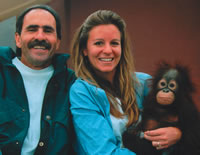 With
an innate love for animals, Terry Moore knew from the time he was
little that when he grew up he wanted to work with animals. He just
didn’t know it would be in conjunction with the movie business.
Terry grew up in Utah and at one point thought about becoming a
veterinarian, but decided it would be too depressing for him to
be around sick animals all the time. So in 1977, Terry went to a
school called Gentle Jungle in Colton, California. In a two-year
college accredited program, Terry learned how to train with the
250 exotic animals at the school. He specialized in training exotic
animals to do stunts. Terry took a year off before graduating from
the program to take people bear viewing and whale watching in Alaska.
After graduating from the program, Terry began working for Cougar
Hill Ranch as one of their employees who doubled for actors in movies
with animal stunts.
With
an innate love for animals, Terry Moore knew from the time he was
little that when he grew up he wanted to work with animals. He just
didn’t know it would be in conjunction with the movie business.
Terry grew up in Utah and at one point thought about becoming a
veterinarian, but decided it would be too depressing for him to
be around sick animals all the time. So in 1977, Terry went to a
school called Gentle Jungle in Colton, California. In a two-year
college accredited program, Terry learned how to train with the
250 exotic animals at the school. He specialized in training exotic
animals to do stunts. Terry took a year off before graduating from
the program to take people bear viewing and whale watching in Alaska.
After graduating from the program, Terry began working for Cougar
Hill Ranch as one of their employees who doubled for actors in movies
with animal stunts.
Terry has worked in such films as “Back To The Future III,”
“Swiss Family Robinson,” “Anaconda,” “Cry
In The Wild,” “Runaway Train,” “Mogli’s
Story,” and many more, not to mention being on The Johnny Carson
Show.
“I’m a fairly average size guy which made it easy for
me to double for most actors,” says Terry, “but in movie
credits, animal trainers are listed right after the guys that clean
the bathrooms.”
Terry informed me that to double as any major actor with a big animal
stunt usually fetches $10,000 per stunt, which isn’t a whole
lot when you consider that if something goes wrong it could be fatal.
In “Back To The Future III,” Terry was dressed as Michael
J. Fox to do the bear chasing scene.
“There is always an element of risk involved when working with
wild animals,” says Terry. “People should know that wild
animals never make pets. They may be trained, but are never tame.
It took man over 10,000 years just to domesticate dogs. You realize
that no matter how long you’ve worked with an animal or how
loving or playful they may be; in the back of your mind you’re
always aware that at any instant they can revert to instinct and
aggressively strike you. The biggest risk involved is when people
don’t know how to read an animal. Animals will tend to warn
you and you have to be in constant communication with the animal.”
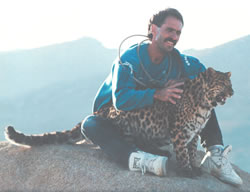 In
the twenty years that Terry has been in the movie business, he has
only been bitten four times. Every one of those instances could
have been avoided and were usually the case of an extra stunt or
“shot” that went against Terry’s instinct and better
judgement. It is always human failings that cause mistakes. In the
film “Swiss Family Robinson,” Terry does a chase scene
with a black jaguar. These types of scenes run the risk of the cat,
bear or whatever doing the chasing, becoming “turned on”
by chasing prey or the baiting act. In these types of scenes, Terry
says that there is a cool down period right after this type of shot.
But the director liked the stunt so much that he wanted one more
shot, and though Terry didn’t feel right about it, he agreed.
In this particular instance, the animal handler and Terry ended
up prying the jaguar’s jaws off Terry’s leg. Mind you,
this isn’t just some jaguar that is brought on a set from out
of nowhere. Most animal training businesses are family owned and
the trainer and handler establish a relationship with the animal
at a very early age.
In
the twenty years that Terry has been in the movie business, he has
only been bitten four times. Every one of those instances could
have been avoided and were usually the case of an extra stunt or
“shot” that went against Terry’s instinct and better
judgement. It is always human failings that cause mistakes. In the
film “Swiss Family Robinson,” Terry does a chase scene
with a black jaguar. These types of scenes run the risk of the cat,
bear or whatever doing the chasing, becoming “turned on”
by chasing prey or the baiting act. In these types of scenes, Terry
says that there is a cool down period right after this type of shot.
But the director liked the stunt so much that he wanted one more
shot, and though Terry didn’t feel right about it, he agreed.
In this particular instance, the animal handler and Terry ended
up prying the jaguar’s jaws off Terry’s leg. Mind you,
this isn’t just some jaguar that is brought on a set from out
of nowhere. Most animal training businesses are family owned and
the trainer and handler establish a relationship with the animal
at a very early age.
“With carnivores,” explains Terry, “You begin when
their eyes open. I’ve trained numerous large cats as adults
and over a dozen large cats from the time their eyes opened. You
bottle feed them and become their surrogate mother. You’re
with them every day of their lives, training and being with them.”
“Do these animals come out of the wild?” I asked.
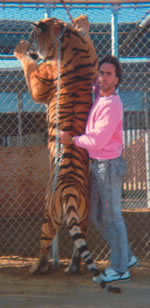 “No.
Animals for the movies never come out of the wild,” says Terry.
Most of them were originally surplus zoo animals and have now been
bred several generations in captivity. Even so, every animal has
its own disposition and not every animal born in captivity is suited
for stunt training.”
“No.
Animals for the movies never come out of the wild,” says Terry.
Most of them were originally surplus zoo animals and have now been
bred several generations in captivity. Even so, every animal has
its own disposition and not every animal born in captivity is suited
for stunt training.”
Some, are better suited as breeding animals. Poncho is a well known
jaguar that Terry trained and is used on the Jaguar car commercials.
He has two siblings that will only be used as breeding animals because
they do not have the temperament needed for movie work.
What is consistant about the movie industry, is that you are extremely
careful not to do things that can be construed as abusive. The American
Humane Society is there for every shot, making sure that everything
is checked before being carried out. The other side to this is that
animals can become spoiled and are smart enough to figure out, that
when in a crowd, they can work it to their own advantage. Terry
remembers a bear that demanded “Kentucky Fried Chicken”
every morning before he would stand up and growl, which was the
behavior he was to perform.
Speaking specifically of types of training, Terry pointed out the
difference between obedience training and behavioral training. With
behavioral training one asks the animal for cooperation and the
animal is immediately rewarded. Most often a clicker or bell is
used as the bridge between the behavior and the reward. There is
more of a partnership that is established.
With animals such as lizards or scorpions, their environment, such
as heat and cold is changed to get the desired response. Spiders
can generally be motivated to move in a certain direction with a
shot of canned air.
“But a lot of animal work will become obsolete because of animatronics,”
says Terry. “It’s also less expensive and there’s
no insurance to worry about.”
Terry says the most important thing to remember in training your
own pet, is consistancy. Go for 15 minutes a day the same time every
day. Practice 2-3 behaviors with the same consistant voice commands
and with the same person. You won’t get very far if you only
train once a week or less often and sometimes the kids train with
the pet, sometimes mom or dad train the pet. Dogs especially want
to please their owners. So make it fun, make it a game with lots
of rewards.
After 20 years, Terry left large animal training to educate people
about bears and their habitat. He was also involved with educational
outreach programs.
So how did Terry end up in Moab, Utah? Two years before moving to
Moab, Terry and his wife Marcee ran a bear viewing lodge in the
Lake Clark Wilderness area of Alaska. In Juneau, they ran a whale
watching lodge and took people kayaking. It was during one winter
at 30° below 0° not having seen civilization for 6 months,
that Marcee said, “I’d like a neighbor. Just one neighbor.
And I’d like to move somewhere I can drive to town.” Since
Terry grew up in Utah, he suggested they move there. It took awhile
to find the perfect place.
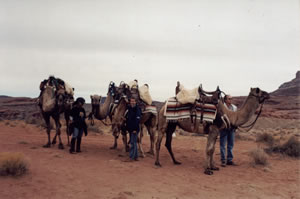 Though
Terry liked working with big cats, he had always enjoyed camels,
especially in context with other people. Somewhere between finding
Moab and the Veterinarian in Park City, a camel adventure business,
“Camelot Adventure Lodge” was born. The Lodge is situated
about 17½ miles from Moab, just beyond Hurrah Pass, taking
Kane Creek Road.
Though
Terry liked working with big cats, he had always enjoyed camels,
especially in context with other people. Somewhere between finding
Moab and the Veterinarian in Park City, a camel adventure business,
“Camelot Adventure Lodge” was born. The Lodge is situated
about 17½ miles from Moab, just beyond Hurrah Pass, taking
Kane Creek Road.
Terry and Marcee purchased a baby camel whom they named Guinevere
from the Park City vet that ran her camel treks in the San Rafael
Swell. In the end, Terry and Marcee ended up working out a deal
and buying all the camels from this vet. Bill, Clyde, Raji and Curly
joined Guinevere at Camelot Lodge. Clyde is also of movie fame as
he was the camel that trekked across the desert with Will Smith
in the movie “Independence Day.”
Camels are called “The Ships of the Desert,” with good
reason. The guests who have stayed with Terry and Marcee that have
also ridden horses claim a camel is a much smoother ride. Each saddle
is custom made to fit each camel.
Terry says camels are more intelligent than horses, “except
for maybe barrel racing.” They are not as agile as horses,
but are much easier to train. They are more sure footed than horses
and can carry horrendous loads, not to mention their inherent drought
and heat tolerance. The camels are also not spooked by the ATV’s
that whiz by, nor does the 4th of July give them any starts. Interestingly
enough, they graze on prickly pear cactus, tumble weeds and tamarisk
including the bark. But Terry and Marcee feed them hay regularly
as well. A bull will average 1600 pounds, and a camel can cost anywhere
from $12,000 to $20,000 each, depending on their training. Terry
also says that camels have a remarkable memory. Even ten years after
the first trek, they take the same trail through sand dunes, though
the sand has shifted.
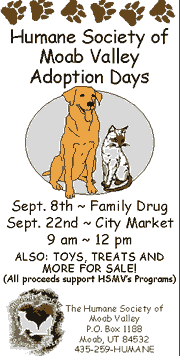 Terry
asked me if I knew where camels originated. Of course, my first
thought was the Middle East, or Africa, but to my surprise, Terry
informed me that they originated in North America. “Camels
have been domesticated longer than any other ungulate. There are
remains of camels on this continent that date back 35 million years.
They crossed the Berring land strait with humans and those that
remained became extinct,” said Terry.
Terry
asked me if I knew where camels originated. Of course, my first
thought was the Middle East, or Africa, but to my surprise, Terry
informed me that they originated in North America. “Camels
have been domesticated longer than any other ungulate. There are
remains of camels on this continent that date back 35 million years.
They crossed the Berring land strait with humans and those that
remained became extinct,” said Terry.
Terry and Marcee will be holding their first camel camp for 3 days
this November. The trek will head towards Chicken Corners.
About twice a year Terry and Marcee get calls from the movie industry
to film on location at the Lodge. The latest one is called “Ice
Age,” and is scheduled for release next spring on the Discovery
Channel.
It seems Terry and Marcee have combined the best of both worlds.
They’re still involved with animals and people, run a camel
adventure lodge, without the 30° below weather, and still get
in on a film or two. I don’t know who their one neighbor might
be, but then, maybe being able to drive into town once a week makes
up for that.
If you’re interested in a camel ride, you can call Camelot
Adventure Lodge at 260-1783.
© 2001 Moab Happenings.
All rights reserved. Reproduction of information contained in this
site is expressly prohibited.